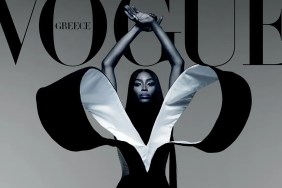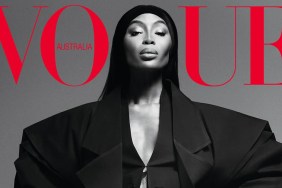Here’s the statement Numero sent back, in full:
“Some people have declared that they have been offended by the publication in Numéro magazine n°141 of March 2013, of an editorial realized by the photographer Sebastian Kim called ‘African Queen’, featuring the American model Ondria Hardin posing as an ‘African queen,’ her skin painted in black.
The artistic statement of the photographer Sebastian Kim, author of this editorial, is in line with his previous photographic creations, which insist on the melting pot and the mix of cultures, the exact opposite of any skin color based discrimination. Numéro has always supported the artistic freedom of the talented photographers who work with the magazine to illustrate its pages, and has not took part in the creation process of this editorial.
For its part, Numéro Magazine, which has the utmost respect for this photographer’s creative work, firmly excludes that the latest may have had, at any moment, the intention to hurt readers’ sensitivity, whatever their origin.
Numéro Magazine considers that it has regularly demonstrated its deep attachment to the promotion of different skin-colored models. For instance, the next issue of Numéro for Man on sale on 15th march has the black model Fernando Cabral on the cover page, and the current Russian edition’s cover of our magazine features the black model Naomi Campbell on its cover. This demonstrates the completely inappropriate nature of the accusations made against our magazine, deeply committed to the respect for differences, tolerance and more generally to non-discrimination.
Considering the turmoil caused by this publication, the Management of Numéro Magazine would like to apologize to anyone who may have been offended by this editorial.”

Photographer Sebastian Kim sent in his own apology:
“I would like to apologize for any misunderstanding around my recent photos for Numero France. It was never my intention (nor Numero’s) to portray a black woman in this story. Our idea and concept for this fashion shoot was based on 60s characters of Talitha Getty, Verushka and Marissa Berenson with middle eastern and Moroccan fashion inspiration. We at no point attempted to portray an African women [sic] by painting her skin black. We wanted a tanned and golden skin to be showcased as part of the beauty aesthetic of this shoot.
It saddens me that people would interpret this as a mockery of race. I believe that the very unfortunate title ‘African Queen’ (which I was not aware of prior to publication) did a lot to further people’s misconceptions about these images. It was certainly never my intention to mock or offend anyone and I wholeheartedly apologize to anyone who was offended.
Sincerely,
Sebastian Kim”
The two statements above are a study in contrasts. Kim’s short and direct response articulates his original concept and makes a convincing case that the controversy was the result of a misunderstanding. His apology seems sincere, and I can see how he envisioned the editorial as a story about a Maria Berenson or Talitha Getty-type glamour girl. And yes: like him, I believe that it didn’t read that way because of how it was framed by the publication.
Numero‘s defensive, drawn-out comment is less sympathetic: If Kim’s original concept was for the most part inoffensive, the glossy’s packaging of the editorial is another story. Numero not only ran the feature under the title “African Queen,” the publication also truly believed that the pictures showed a white girl with her skin painted black posing as an ‘African queen,’ and didn’t think that was a problem. I understand that in France, sensitivity to questions of racial justice might not be as sophisticated as what we’re used to in the U.S., but as HuffPo pointed out, Numero‘s made this mistake before: in 2010, the French publication ran an editorial set in something resembling a savanna, featuring an “overbronzed” Constance Jablonski styled with an Afro, posing with a black baby.
Despite its willingness to, as Numero points out in its statement above, hire some black models sometimes (the references to its Fernando Cabral and Naomi Campbell covers are the magazine equivalent of being like, “I’m not racist — I have black friends!”), the publication clearly has a race problem. It’s incredible that, thinking he’d deliberately styled Hardin in blackface, no one at Numero reached out to Kim to at least be like, “Hey, some people might find this offensive and that’s totally fine with us (we’re all about making fashion statements with blackface!), but just checking in — That’s what you’re going for, right?” Still more remarkable: after seeing how people responded to the editorial, Numero did what looks like zero soul-searching, releasing a statement which reads like they think we’re the ones that should be apologizing for being offended in the first place.
Images via TFS Forums
Previously: Numero’s Racist “African Queen” Editorial Stars White Model Ondria Hardin in Blackface





